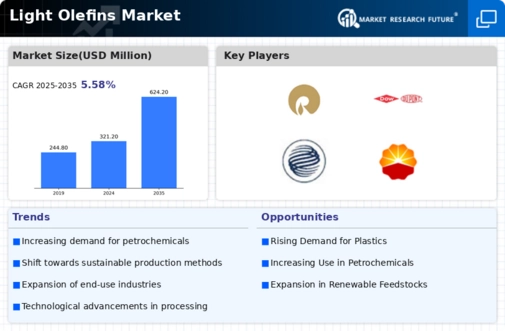Market Growth Projections
The Global Light Olefins Market Industry is projected to experience substantial growth over the coming years. With a market value expected to reach 321.2 USD Million in 2024 and further expand to 624.2 USD Million by 2035, the industry is poised for a robust trajectory. The anticipated compound annual growth rate of 6.23% from 2025 to 2035 reflects the increasing demand for light olefins across various sectors. This growth is underpinned by technological advancements, expanding applications, and supportive regulatory frameworks that collectively enhance the market's potential.
Expansion of End-Use Industries
The expansion of end-use industries such as packaging, textiles, and consumer goods is a key driver for the Global Light Olefins Market Industry. As these sectors grow, the demand for light olefins, particularly ethylene and propylene, is expected to rise correspondingly. The versatility of light olefins in producing various materials, including films, fibers, and containers, positions them as essential raw materials in these industries. This growth trajectory is likely to be supported by increasing consumer preferences for sustainable and recyclable products, further enhancing the market's potential. The ongoing expansion of these industries is anticipated to significantly contribute to the overall market dynamics.
Rising Demand for Petrochemicals
The Global Light Olefins Market Industry is experiencing a surge in demand for petrochemicals, driven by their extensive applications in various sectors such as automotive, construction, and consumer goods. As industries increasingly rely on light olefins for the production of plastics and synthetic fibers, the market is projected to reach 321.2 USD Million in 2024. This growth is indicative of the broader trend towards lightweight materials that enhance fuel efficiency and reduce emissions, aligning with global sustainability goals. The increasing adoption of light olefins in manufacturing processes is likely to further bolster market expansion.
Technological Advancements in Production
Technological innovations in the production of light olefins are significantly influencing the Global Light Olefins Market Industry. Advanced catalytic processes and improved cracking technologies enhance yield and reduce production costs. For instance, the development of more efficient steam cracking methods allows for higher output of ethylene and propylene, which are key components in various chemical products. These advancements not only improve profitability for manufacturers but also contribute to meeting the growing global demand. As a result, the market is expected to witness a compound annual growth rate of 6.23% from 2025 to 2035, reflecting the positive impact of these technological improvements.
Growing Applications in Automotive Sector
The automotive sector is increasingly adopting light olefins for the production of lightweight materials, which are essential for enhancing fuel efficiency and reducing carbon emissions. The Global Light Olefins Market Industry benefits from this trend, as manufacturers seek to incorporate materials derived from light olefins into vehicle components. This shift is driven by stringent regulations aimed at reducing environmental impact, prompting automakers to innovate. As the automotive industry evolves, the demand for light olefins is likely to escalate, contributing to the projected market growth to 624.2 USD Million by 2035. This trend underscores the pivotal role of light olefins in sustainable automotive manufacturing.
Regulatory Support for Sustainable Practices
Regulatory frameworks promoting sustainable practices are increasingly shaping the Global Light Olefins Market Industry. Governments worldwide are implementing policies that encourage the use of environmentally friendly materials and processes, which often include light olefins. These regulations aim to reduce carbon footprints and promote recycling, thereby enhancing the appeal of light olefins in various applications. As industries adapt to these regulations, the demand for light olefins is expected to rise, aligning with global sustainability initiatives. This supportive regulatory environment is likely to drive market growth, as companies seek to comply with evolving standards and consumer expectations.





